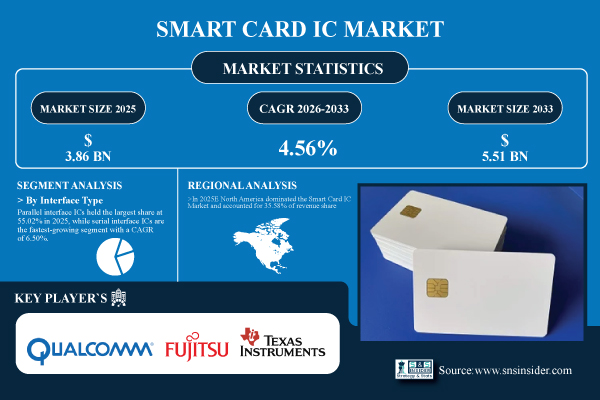
News
October 07, 2025
Smart Card IC Market Size to Grow USD 5.51 Billion by 2033 Due to Rapid Adoption of Secured Integrated Circuits across Multiple Sectors | SNS Insider
The U.S. Smart Card IC Market is estimated at USD 1.01 billion in 2025 and is projected to reach USD 1.40 billion by 2033, growing at a CAGR of 4.21% during the forecast period 2026–2033. The U.S. Smart Card IC Market is estimated at USD 1.01 billion in 2025 and is projected to reach USD 1.40 billion by 2033, growing at a CAGR of 4.21% during the forecast period 2026–2033.
The global smart card IC market is poised for significant expansion, with projections indicating a growth of USD 5.51 billion by 2033. This surge is fueled by the increasing adoption of secured integrated circuits across a diverse range of sectors, highlighting the growing importance of secure data storage and processing in modern applications.
Smart card integrated circuits (ICs) are the brains behind smart cards, enabling them to perform various functions like storing information, processing data, and authenticating identities. These circuits are embedded within the card and are crucial for secure transactions and access control.
The United States is expected to be a major contributor to this global growth. Specifically, the U.S. smart card IC market is currently valued at an estimated USD 1.01 billion in 2025. Forecasts predict a substantial increase to USD 1.40 billion by 2033. This represents a Compound Annual Growth Rate (CAGR) of 4.21% throughout the forecast period, spanning from 2026 to 2033. This steady growth signifies a consistent demand for smart card technology within the U.S. market.
The factors driving this expansion are multifaceted. As data breaches and cyber threats become increasingly prevalent, the need for secure identification and authentication methods is more critical than ever. Smart cards offer a robust solution for protecting sensitive information, making them attractive for applications in financial services, government identification, healthcare, and transportation.
For example, in the financial sector, smart cards are used for secure credit and debit card transactions, reducing the risk of fraud. Government agencies utilize them for secure identification cards and access control systems. Healthcare providers employ smart cards to store patient medical records securely, ensuring privacy and data integrity. In transportation, smart cards are used for ticketing systems and secure access to public transport.
The consistent growth rate projected for the U.S. market reflects a strong and sustained demand for smart card ICs. As technology continues to evolve and new applications emerge, the smart card IC market is expected to remain a dynamic and vital sector within the broader electronics industry. The demand for secure and reliable identification and data storage solutions will continue to drive innovation and growth in this field.
Smart card integrated circuits (ICs) are the brains behind smart cards, enabling them to perform various functions like storing information, processing data, and authenticating identities. These circuits are embedded within the card and are crucial for secure transactions and access control.
The United States is expected to be a major contributor to this global growth. Specifically, the U.S. smart card IC market is currently valued at an estimated USD 1.01 billion in 2025. Forecasts predict a substantial increase to USD 1.40 billion by 2033. This represents a Compound Annual Growth Rate (CAGR) of 4.21% throughout the forecast period, spanning from 2026 to 2033. This steady growth signifies a consistent demand for smart card technology within the U.S. market.
The factors driving this expansion are multifaceted. As data breaches and cyber threats become increasingly prevalent, the need for secure identification and authentication methods is more critical than ever. Smart cards offer a robust solution for protecting sensitive information, making them attractive for applications in financial services, government identification, healthcare, and transportation.
For example, in the financial sector, smart cards are used for secure credit and debit card transactions, reducing the risk of fraud. Government agencies utilize them for secure identification cards and access control systems. Healthcare providers employ smart cards to store patient medical records securely, ensuring privacy and data integrity. In transportation, smart cards are used for ticketing systems and secure access to public transport.
The consistent growth rate projected for the U.S. market reflects a strong and sustained demand for smart card ICs. As technology continues to evolve and new applications emerge, the smart card IC market is expected to remain a dynamic and vital sector within the broader electronics industry. The demand for secure and reliable identification and data storage solutions will continue to drive innovation and growth in this field.
Category:
Technology